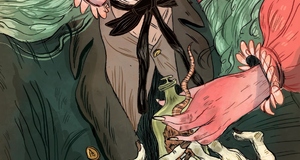Characterization in John Updike's "You'll Never Know, Dear, How Much I Love You"
By
2014, Vol. 6 No. 09 | pg. 1/2 | »
KEYWORDS:
In an interview in The Paris Review (1968), John Updike denies that characterization is a primary goal of fiction. While he believes that narratives can contain psychological insights, he argues that the “substance” of a story is the “appetite for motion, for suspense, for resolution” (Samuels, 1968). According to Updike, “the author's greatest pride... is in his ability to keep an organized mass of images moving forward” (Samuels, 1968). Despite Updike's personal beliefs, various scholars argue that his works tend to be character driven rather than plot driven. The protagonist is an integral component in Updike's “You'll Never Know, Dear, How Much I Love You.” Updike's characters are perhaps the most important elements of his stories, especially this story, because they embody traits that bring them – and the stories – to life. Though Updike asserts characterization is not his main focus, his narrative “You'll Never Know, Dear” is an example of a short story that is driven and directed by its characters rather than its plot because of the main character's thoughts, actions, and physical descriptions.
Updike's “You'll Never Know, Dear” is a story driven by the main character's thoughts. In the beginning of the story, Ben's thoughts are full of eagerness and excitement. The first paragraph of the story is crafted to express his thoughts, as though it portrays the notion that he is pleading with his parents to give him money so he can join his friends at the carnival: Now, now, gather your pennies; supper is over and an hour of light is left in the long summer day. See, Sammy Hunnenhauser is running; Gloria Gring and her gang have been there all afternoon, they never go home, oh hurry, let me go; how awful it is to have parents that are poor, and slow, and sad! (Updike, 1962, p. 172) He wants the money immediately, and he wants to get to the fair as quickly as possible, illustrating his impatience and anticipation. Furthermore, Ben's focus is on his parents' financial state and how he wishes they were more fortunate. His thoughts are a driving force even in the beginning of the story because they set the tone; his dissatisfaction with his family is apparent, as well as his childish nature. Once he gets to the fair, however, Updike describes Ben as feeling like a “fool” because the place is much emptier than he expected it to be (p. 173). Ben's age, coupled with his emotions, is evident in his character. A ten-year-old's enthusiasm is generally admirable, and Ben fits the description. He is still too young to comprehend the difference between expectation and reality; he has not quite discovered that some events do not live up to the hype. According to Jack De Bellis, Updike's characters can be classified into categories such as “searchers, finders, reality instructors and the trapped” (2000, p. 99) Updike crafts Ben as both a searcher, as he is portrayed as an innocent boy full of life and vigor and looking for entertainment and as someone who is trapped because of his financial situation, his age, and his awareness of the harshness of the world. His youthful naiveté is apparent when he glances over his neighbor's roof at the pink Ferris wheel, the “great notched rim of the coin sweating in his hand” (Updike, 1962, p. 173). Similarly, the juxtaposition and characterization of a shameful Ben come at the end of the story, when he is “trying to hide from every sailor and fat woman and high-schooler who witnessed his disgrace” (Updike, 1962, p. 178). The way Ben formulates his thoughts are indicative of his young character and helps the story progress. Updike is able to take us to “the heart of a character” in a single phrase (Samuels, 1969). Charles Thomas Samuels, the same man who conducted the interview with Updike in The Paris Review, believes that Updike can provide a reader with full understanding of the inner workings of a character's mind. As mentioned above, Ben's thoughts serve as a major source of his characterization. In the essay “Character in Contemporary Fiction,” Brian Phillips speaks about the fruition of a character, stating that “what is said in description or narration is scrutinized in innumerable ways, each of which... contributes to the shape of the person who begins to exist in our imagination” (2004, p. 629). The ways in which Updike provides readers with the ability to see inside Ben's mind and understand him as a character are what makes him believable and an accurate representation of a ten-year-old boy. Likewise, Robert Saunders Dowst argues in his book, The Technique of Fiction Writing, that a direct statement made by an author about a character must be backed up by that character's deeds (Dowst, 1921, p. 146). Updike can concoct a character with any qualities he so pleases; he can choose to make Ben outgoing, angry, timid, and so on, and while what Updike writes about the character will stand true, it will have no significance if he does not make the character embody his description. Dowst says that a “mere statement is less impressive and less compelling than a demonstration” (Dowst, 1921, p. 146). Updike crafts Ben as a disillusioned character, and while the audience is able to get a feel for this, it's not until the inner workings of Ben's mind are presented for the full effect to take place. “You'll Never Know, Dear” is also driven by the main character's speech, which can also be considered his thoughts, as they are his primary means of expression. At the end of the story, Ben loses all of his money playing a card game. The game is one in which he places bets on certain numbers, hoping that when the wheel is spun, it lands on one of the numbers he has chosen. After it does not, and he loses, the man running the wheel asks, “Whatsamatta with ya, ya daddy rich” (Updike, 1962, p. 177). Readers know nothing about the man running the game whatsoever, but they can infer that he is not a nice man for picking on a young boy. In spite of Ben's age, Updike describes him as having a full awareness of the situation, as tittering adults surround him. Ben is apparently familiar with being a “comic prop” and “wants to explain that he knows his eyes are moist and his cheeks red but it's because of joy, freedom, not because of losing” (Updike, 1962, p. 177). However, by choosing to limit Ben's speech to a simple “no,” Updike demonstrates that Ben knows his place in society, respects authority, and maintains his role as a child. Dialogue is a way in which characterization serves as a driving point for Updike's “You'll Never Know, Dear.” An article by Rex Burns (1998, p. 13) states that the “clearest and most often subtle means of presenting character is through dialogue.” Burns says a character's speech often portrays the character himself. The diction and syntax of dialogue, in addition to the scene in which the conversation takes place, carries the character. For example, there should be no need to use an adverb to say a character spoke “nervously”; that should be conveyed through dialogue. Additionally, Dowst asserts that the “appeal of written speech is indefinitely more direct and more compelling than that of any other sort of writing” (1921, p. 124). It is imperative that a writer capture speech as naturally as possible because it's a powerful tool, and the more powerful it is, “the more damage it will do if mismanaged” (Dowst, 1921, p. 125). A skilled author uses dialogue to his advantage; he uses it as a crutch to make an already realistic character even more believable. If a character's words are kept in accordance with the person himself, they will give him the “breath of life” (Dowst, 1921, p. 125). While “You'll Never Know, Dear,” contains a limited amount of dialogue, the words that Updike does write for Ben to speak are filled with importance; they serve to shape his character. Furthermore, characters' actions often serve as a directional guide for a work of fiction. Ben's actions are imperative to fully identify the innocence he embodies and the way in which he is beguiled by the fair. Updike writes about Ben's ability to be easily manipulated by the amount of money in his pocket and how quickly he spends it: "The fifty-cent piece feels huge to Ben's fingers, a wide oppressive rigidity that must be broken, shattered into twinkling fragments, to merge in the tinsel and splinters of strewn straw. He buys, at the first stand he strikes, a cone of cotton candy, and receives, with the furry pink pasty uncoiling thing, a quarter, a dime, and a nickel: three coins, tripling his wealth." (Updike, 1962, p. 174) Updike illustrates Ben's ten-year-old logic: three coins, in this case, must be worth more money than a single one. Ben does not take the time to peruse all of the different stands at the carnival and experience all there is to offer. Up until this point, he has not had this much money or this much freedom before, and he wants to spend the money as quickly and carelessly as possible. Unconcerned about what merchandise is for sale in other areas and the cost of what he is buying, Ben acts impulsively, gratifying himself.Continued on Next Page » Suggested Reading from Inquiries Journal
Inquiries Journal provides undergraduate and graduate students around the world a platform for the wide dissemination of academic work over a range of core disciplines. Representing the work of students from hundreds of institutions around the globe, Inquiries Journal's large database of academic articles is completely free. Learn more | Blog | Submit Latest in Literature |

















